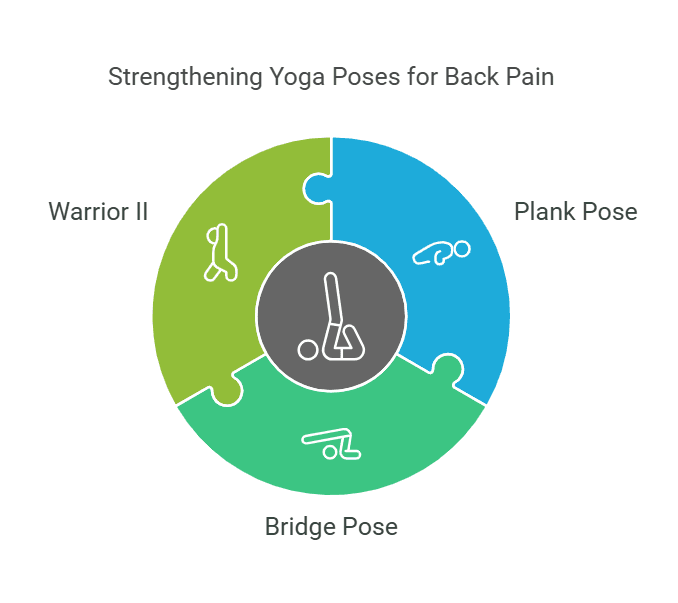Yoga has long been celebrated for its numerous health benefits, particularly in promoting flexibility, strength, and mental well-being. One of the most significant advantages of practicing yoga is its ability to alleviate back pain, a common ailment affecting millions worldwide. In this blog post, we will explore effective yoga workout specifically designed to relieve back pain, supported by statistics and expert insights. Whether you’re a seasoned yogi or a beginner, these tips will help you incorporate yoga into your routine to enhance your overall health and well-being.

Understanding Back Pain
Back pain is a widespread health concern, affecting a significant portion of the global population. Studies reveal that approximately 80% of adults experience back pain at some point during their lives, making it one of the most common health issues. The American Chiropractic Association (ACA) identifies back pain as a leading cause of missed workdays and a major contributor to disability worldwide, highlighting its profound impact on both personal well-being and economic productivity.
The causes of back pain are diverse, ranging from acute injuries to chronic conditions. Common triggers include:
- Muscle Strains: Overexertion or sudden movements can lead to strained muscles or ligaments in the back.
- Herniated Discs: When the soft cushioning between spinal vertebrae ruptures or bulges, it can press on nerves, causing pain.
- Poor Posture: Slouching or improper alignment while sitting, standing, or lifting can strain the spine over time.
- Sedentary Lifestyles: Prolonged periods of inactivity weaken the core and back muscles, making them more susceptible to pain.
Understanding the underlying causes is essential for effective prevention and management. Addressing lifestyle factors, such as maintaining good posture and engaging in regular physical activity, can play a critical role in reducing the risk and severity of back pain.
The Role of Yoga Workout in Alleviating Back Pain
Yoga workout have proven to be a highly effective approach to managing and alleviating back pain. According to a study published in the journal Pain, individuals who participated in regular yoga sessions experienced notable reductions in pain levels and enhancements in their functional abilities compared to those who did not incorporate yoga into their routine. This aligns with findings from the National Center for Complementary and Integrative Health (NCCIH), which highlights yoga’s capacity to improve flexibility, strength, and posture—key factors in maintaining a healthy and pain-free back. By addressing physical imbalances and promoting relaxation, yoga offers a holistic solution to back pain management.
Tips for an Effective Yoga Workout for Back Pain
1. Start with Gentle Poses
If you’re new to yoga or experiencing acute back pain, it’s essential to start with gentle poses that promote relaxation and stretching. Here are a few beginner-friendly poses to consider:
- Child’s Pose (Balasana): This restorative pose helps stretch the back and hips while promoting relaxation.
- Cat-Cow Stretch (Marjaryasana-Bitilasana): This dynamic movement helps increase spinal flexibility and relieve tension in the back.
- Downward-Facing Dog (Adho Mukha Svanasana): This pose stretches the entire back and hamstrings, helping to alleviate tightness.
2. Focus on Alignment
Proper alignment is crucial in yoga to prevent further injury and ensure maximum benefits. Pay attention to your body and make adjustments as needed. Consider using props such as blocks or straps to help maintain alignment and support your body in various poses.
3. Incorporate Strength-Building Poses

Building strength in the core and back muscles can help support the spine and reduce the risk of injury. Incorporate poses such as:
- Plank Pose (Phalakasana): This pose strengthens the core, shoulders, and back, providing stability and support.
- Bridge Pose (Setu Bandhasana): This pose strengthens the lower back and glutes while stretching the chest and spine.
- Warrior II (Virabhadrasana II): This pose builds strength in the legs and core while promoting good posture.
4. Practice Mindfulness and Breathing Techniques
Mindfulness and deep breathing are integral components of yoga that can help reduce stress and tension in the body. Incorporate breathing exercises such as:
- Diaphragmatic Breathing: Focus on breathing deeply into the diaphragm to promote relaxation and reduce tension.
- Ujjayi Breath: This technique involves slightly constricting the throat while breathing, creating a calming sound that can enhance focus during practice.
5. Listen to Your Body
It’s essential to listen to your body and honor its limits. If a pose causes pain or discomfort, modify it or skip it altogether. Yoga should never be painful; instead, it should promote a sense of ease and relaxation.
6. Consistency is Key
To experience the full benefits of yoga for back pain, consistency is crucial. Aim to practice yoga at least two to three times a week, gradually increasing the duration and intensity of your sessions as you become more comfortable.
Statistics Supporting Yoga Workout for Back Pain Relief
Yoga has emerged as a powerful and evidence-based solution for alleviating back pain. Numerous studies underscore its efficacy, highlighting how it compares favorably to other traditional treatments.
- Yoga vs. Physical Therapy: A pivotal study published in the Annals of Internal Medicine revealed that yoga is as effective as physical therapy in managing chronic low back pain. Participants who engaged in yoga experienced comparable reductions in pain intensity and improvements in functionality, offering a compelling alternative for those seeking non-invasive treatment options.
- Significant Pain Reduction: Research conducted by the University of Washington demonstrated that individuals practicing yoga reported a remarkable 50% reduction in pain levels and enhanced functional abilities after just 12 weeks of consistent practice. This rapid improvement underscores the transformative potential of yoga for chronic pain sufferers.
- Widespread Use: According to the National Center for Complementary and Integrative Health (NCCIH), approximately 14% of U.S. adults have turned to yoga as a strategy for managing back pain. This statistic reflects the growing acceptance of yoga as an effective, holistic approach to addressing back-related discomfort.
Incorporating a yoga workout into your routine can be a powerful tool for managing and alleviating back pain. By focusing on gentle poses, proper alignment, strength-building exercises, mindfulness, and consistency, you can create a sustainable practice that promotes overall health and well-being. Remember to listen to your body and consult with a healthcare professional before starting any new exercise regimen, especially if you have pre-existing conditions. Embrace the journey of healing through yoga, and enjoy the many benefits it has to offer for your back and beyond.
By following these tips and incorporating yoga into your lifestyle, you can take proactive steps toward a healthier, pain-free back. Start your yoga journey today and experience the transformative power of this ancient practice.





